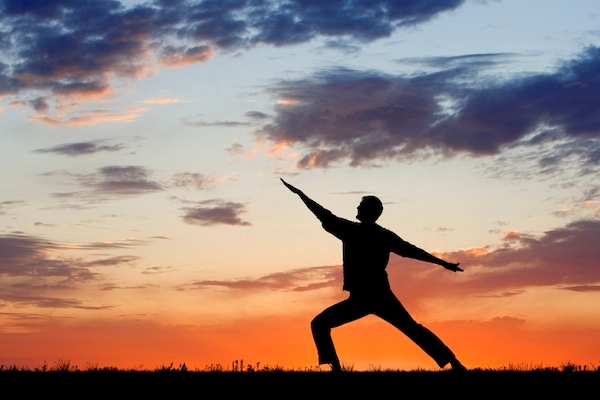Five of us, standing in a semi-circle on a varnished wooden floor facing the yoga teacher, breathing deeply in concert. In through the nose, hold, out through the mouth. Easter Sunday morning. Christ is risen. We slowly inhale and exhale to the sound of distant church bells and the cheeping of a pair of sparrows nesting somewhere in the eaves.
We’re learning Kum Nye, a type of Tibetan yoga. An all-day beginners’ ‘workshop’. I feel guilty about learning Tibetan yoga on Easter Sunday morning. Raised a Baptist, as a youth I was warned strongly against yoga. It empties the mind, I was told, leaving it open and unprotected. Satan, a ravening lion always on the prowl, spots his opportunity and rushes in. And once he’s got in, it’s the devil of a job to get him out again. Astrology the same. Also tarot, hypnotism, meditation and certain kinds of music. I can remember a charismatic church service in which a demon was evicted from one woman, and it flew immediately into another several rows back, from where it taunted the exorcisers most foully.
Early religious indoctrination irretrievably tempered my mind. If my behaviour today runs contrary to what I was taught, it is not because I no longer believe any of it. Worried still about Satan’s desire to infiltrate my mind, I told myself I would go to the all-day yoga workshop, but in the thoughtful silences, if the practice of Tibetan yoga permitted any, I would ward him off by contemplating the significance of the crucifixion and the empty tomb.
Tibetan yoga was a new one on me. I’d seen the workshop advertised and had been excited and seduced by the juxtaposition of the words Tibetan and yoga, that’s all. Knowing the Tibetans’ reputation for esoteric religious knowledge, I imagined that Tibetan yoga would make ordinary yoga look like materialism. As we breathed slowly in and out, like a row of locomotives gently getting up steam, I glanced sideways at my fellow yogis.
To my left, three women, their slender frames and angular features patently cast from the same mould. A mother and her two daughters. The daughters’ bodies showed the poise and limber grace of ballerinas and, when in motion, suppleness. They looked as if it would be possible to fold them in half, and then fold them in half again.
To my right, a middle-aged man wearing an old cotton T-shirt stretched over a gourmand’s belly. He looked confident and relaxed — he had done this before, obviously — and he seemed to find almost everything the teacher said amusing. I took this humorous, self-satisfied chap to be a British Grand High Wizard of Tibetan yoga on his day off.
Before we’d started our concentrated breathing, the teacher had given a spoken introduction. Essentially, Tibetan yoga was about two things, she said. It was about exploring to the fullest extent what kind of creatures we are, and it was about cultivating the correct attitude for the relishing of the crowning moment of our lives, which is our dying. During this introduction she veered off at an interesting tangent. She’d practised meditation with the utmost dedication for 27 years, she said, then given it up as a waste of time because it made her miserable and self-obsessed. This was a surprisingly frank and generous admission, I thought, and worth the £35 course fee on its own.
We began the moves. Here’s the thing about Tibetan yoga as opposed to your bog standard Hatha yoga. The moves are incredibly, almost ludicrously, simple. For the first exercise we extended our arms out to the sides, then brought them up very slowly, as slowly as the second hand on a ticking clock (breathing concentratedly in through the nose and out through the mouth) until they met in an apex above our heads. And then we brought them down again as slowly. And then we repeated this very deliberate action for what seemed like about three weeks.
After that we widened our stance a little and lifted up our poor arms again, and stood there motionless like that, crucified in the shape of an X, listening to the celebratory pealing of distant church bells and the cheeping of house sparrows, for what felt like about another three weeks.
Finally, the teacher invited us to come down from our crosses and, keeping our eyes closed, to examine inwardly the sensations that were occurring in our shoulders and arms and in our heads. My head felt most peculiar. If I had to describe it, I’d have said it felt like a tropical aquarium with shoals of tiny cichlids, guppies and minnows darting randomly hither and thither. Fortunately I didn’t have to. Because now we were on to the next move, which began with both arms — the simplicity would have been almost laughable if my arms didn’t hurt so much — extended straight out in front.







Comments